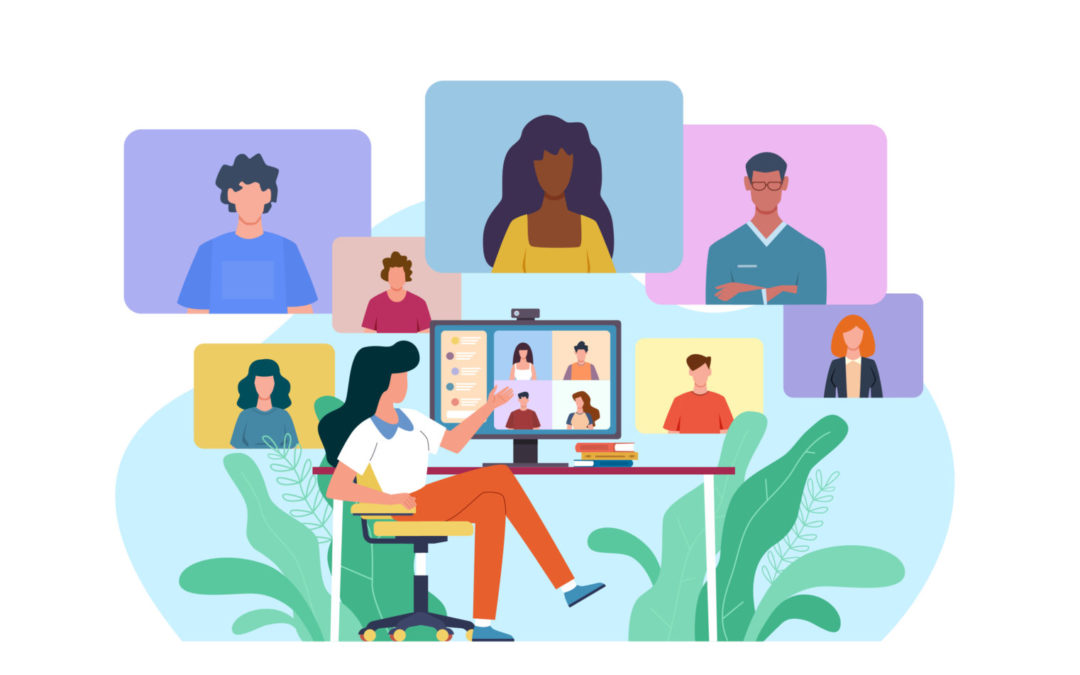
by American Business Women's Association | Feb 14, 2024 | Blog, Business, Uncategorized
To view the complete video, “WHY I JOINED ABWA” – Click the link and/or copy and paste the link into the internet search field: https://youtu.be/iqHYOG_rmcg
About ABWA Member, Dr. Ka’Ryn Holder-Jackson
Dr. Ka’Ryn Holder-Jackson is a dynamic innovative business executive; her expertise is leadership training and development, strategic planning, and organizational development. An articulate, diplomatic, interpersonal communicator with an uncommon ability to influence, motivate, inspire, and communicate with diverse constituents,
A native of San Francisco, she is a graduate of San Francisco State University, where she earned a Bachelor of Science in Psychology, the University of Phoenix, where she earned a Master’s of Business Administration and Capella University where she earned a Doctorate in Human Services.
Ka’Ryn presently serves as the Executive Director of ACCEL San Mateo County Adult Education Consortium where she leads a Ka’Ryn leads a coalition of regional education, training, business and industry partners bridging the gap between employer demand for an educated and skilled workforce and the supply of workers with the necessary skills for a 21st century labor market.
As a former Associate Director for the American Diabetes Association, San Francisco Bay Area, Ka’Ryn received honors as the recipient of a Certificate of Special Congressional Recognition in 2015 from the Honorable Barbara Lee 13th Congressional District of California, In Recognition of Dedication to Educating the Community About Diabetes & the Importance of Health Care.
Ka’Ryn has over 20 years’ experience serving in Executive Management in corporate, for profit, not-for-profit, non-profit, and education Sectors. She is the CEO of A’Ryze Consulting; a Certified Executive Coach, Speaker, Trainer, Corporate Facilitator, and has over 20 years’ experience in the financial services industry and is a licensed financial services representative.
Awards & Recognition:
- 2023 Top Ten Business Woman, American Business Women’s Association
- 2019 Woman of Distinction, American Business Women’s Association
- 2018 Commendation Board of Supervisors of San Mateo County, California
for Leadership in our Communities
- 2015 Certificate of Special Congressional Recognition from the Honorable Barbara Lee 13th Congressional District of California, In Recognition of Dedication to Educating the Community About Diabetes & the Importance of Health Care.

by Rene Street | Mar 30, 2023 | Blog, Uncategorized
There’s never a perfect time to pause your day-to-day work and focus on the internal team, but when you do make the effort, the dividends are immediate. Setting aside an hour, a half-day, a two-day retreat or anything you can manage as a team will provide the opportunity to gather together, grow as a team and refill your collective energy tank in order to bust out of service fatigue and return to delivering excellent customer service in every interaction.
Refill the Team’s Energy
Your first step to regaining the capacity to do your work at your fullest potential is to heighten self-awareness and lean into the responsibility that you must refill your tank. Just like a video game avatar who seizes every opportunity to grab more energy for their harrowing journey ahead, you also need to seek out and embrace the chance to replenish yourselves wherever you find it. The good news is there are easy, actionable ways to find and create more energy for yourself and your whole team. It starts with committing to a “Gather and Grow” mentality that brings a team together (virtually or in person) and facilitates the kind of growth that fills your team’s energy tank and returns your business to a thriving state in the marketplace.
This four-step G.R.O.W. process will show you exactly how.
G – Game On!
Gaming at work might not be an intuitive way to encourage your team to spend their time. But gaming on the job is an easy way to bring hearts and minds together in pursuit of your common professional goals. Friendly sales competitions, staff meetings with moments of levity, and experiential outings with your team are all impactful ways to bust out of service fatigue. To take your workplace gaming to the next level, consider uniting over a cooperative strategy that can break the boredom or monotony of a day. You can boost teamwork qualities through games that bring a team around a collective purpose and goal. These types of efforts are shown to reduce stress and help participants cope with work-related fatigue.
R – Rule Reminders
It seems every business needed to adjust rules, policies, and offerings over the last two years to accommodate the global crisis. Process procedures changed for everything from hotel housekeeping to checking out books from your local library! Frequent change without strong internal communication leads to trouble. Making time to “accuracy audit” will help your team find their footing again when it comes to customer instruction.
Conducting an accuracy audit is easier than it sounds, and it’s the perfect agenda for the next time the team gathers together. Does your website match the current offerings? Do all members of the team know the current rules, even if they only work a few hours a week? Is everyone clear on the current processes of your organization internally and externally? Francis Ford Coppola, the famous film director, was once asked what his secret to success is. He answered, “The first thing I do is make sure that everyone is set is making the same movie.” You are the director of your workplace set. Get all the characters on the same page.
O – Optimism
The dedication to sincerely working toward a better tomorrow is imperative for personal and professional growth. That’s not to say that finding the silver lining in every situation is easy. Far from it. However, when a crowd gathers, its members can feed off each other’s attitudes, mindsets, and perceptions, the good and bad vibes quickly dominoing from one person to the next. For example, observe any boat-rocker on staff who starts a rumor laced with a little over-the-top emotion and see how fast the fire spreads ill-will among the team. Disaster!
However, only you can prevent forest fires! Take the time to gather regularly (even if in a virtual format) and stay in positive communication to decrease the chance of an unnecessary negative spark. Strive to provide frequent updates, truthful status reports, and lead by example with your own optimistic attitude.
W – Warm Welcomes
The odds are good that when your team gathers the next time, there will be new faces on board. Don’t underestimate the power of a warm welcome. No one likes the feeling of being the “new kid in school” and your compassion and kindness (regardless of your position at the company) can go a long way to get new staff off to a great start with the team. Remember to share those unwritten rules everyone else knows about (like, “Use any coffee mug except the purple one with the smiley face. That’s Sandy’s and you all know not to touch it.”) Consider assigning a first-week buddy to each new team member to help shave the learning curve and make them feel at more at home.
Making the time to G.R.O.W. (group gaming, rules review, optimistic outlooks, and warm welcomes) will reboot the energy tank of your organization and make sure everyone is busting out of Service Fatigue with full power and a positive outlook.
About the Author, Laurie Guest
A Hall of Fame keynote speaker and author, Laurie Guest, CSP, CPAE, is an authority on customer service excellence. Laurie blends real-life examples and proven action steps for improvement. She is the author of two books and is writing a third on the topic of service fatigue. To learn more or connect with Laurie, visit www.LaurieGuest.com

by American Business Women's Association | Jan 26, 2023 | Blog, Uncategorized
Being on video and watching videos is today’s business norm. A recent survey showed 76% of consumers watched a video before purchasing a product. Social media influencers promote products through video-based storytelling. You login to video meetings daily with prospects and customers.
Since 2005, the year YouTube launched, video has increasingly grown in prevalence, production value, and consumption. Then in 2020 video marketing took a massive leap forward with the pandemic-induced use of video conferencing, podcasts (with video), and livestreams.
Today, YouTube is the most used social platform for research purposes among business-to-business decisions makers with 50.9% of users. And every day more than 300 million people participate in a Zoom meeting.
The reluctant say about video meetings, “It’s not going away.” Strategic leaders, though, say, “Video is how we do business now.”
In today’s business world all video is video content marketing. Zoom is not a phone call with video. Whether it’s a livestream or a self-produced YouTube short, your videos still need to follow a handful of rules.
Positioning
Some marketers consider the word brand to be a four-letter word. The job of marketers and business leaders, they say, is to position a company or product in the market.
The brand becomes how customers define it, and, hopefully, they define it based on your considerable efforts.
The best marketers see this work of positioning to be the first and most important activity. They have learned to be comfortable with discomfort, because good positioning feels limiting. Good positioning is uncomfortably narrow.
It’s a single, narrowly defined target buyer. Your videos—live and recorded—will improve once you know who you are producing them for and what their motivations are.
Differentiation
What makes you different is what gets people’s attention. Not different for different sake, but a viable, propositional difference which appeals to your ideal buyer.
It’s a noisy, messy, and chaotic market. You want to be a brand which means you can charge a premium. If there is nothing to distinguish yourself from the competition, then you’re a commodity and you can only compete on price.
Your differentiation needs to be relevant and clearly expressed on all your video channels, especially video meetings. The first step is to shift responsibility for video meetings from operations to marketing. The next step, especially with a hybrid workforce, is to make sure that everyone who shows up on video is well trained and that their presence represents the value of the brand.
Distribution
Where to post your videos is determined by positioning and differentiation, not trend or fashion. A fishing guide once said, “You’re not fishing unless you have fish under your boat.” Or as Maverick said to Goose in the first Top Gun, “Target rich environment.”
Distribution can include everything from the social media platform (LinkedIn, TikTok) to the video distributor (YouTube, Vimeo) to the livestream platform. It answers what and how of your video content strategy.
Regardless of platform, you want all your videos to do one thing: direct interested parties to your website. There they learn more about you and begin to fall in love with you.
Distribution isn’t a benign decision. It says a lot about who you are and the people you’re trying to reach.
Story
Stories draw prospects in and customers closer. A well-told story engages the right people into a deeper, more meaningful conversation.
The right story you want to tell elevates the customer as hero. It captures your positioning and differentiation. How you will tell your story—written, audible, or visual—will be determined by the platform you choose and the audience you want to reach.
Tiktok is both a genre of video and a distribution platform. The audience consumes video through a spontaneous scroll. How you tell your story on TikTok may not work on LinkedIn.
Additionally, your video meetings, podcasts, and livestream productions express the story of your brand. The way you show up on video tells a story. But is it the right story? Your video meetings and podcast presence need to set the tone and timbre of future engagements.
Surprise
Better video is an act of kindness. Do everything you can to be more present across the lens.
We all spend enough time in front of a camera. When you show up on camera with a better-than-expected presence, you surprise people. Surprise is one ingredient in being unforgettable.
When you are not present, people check out. When you are present, people respond. Presence is what you say before you say a word.
Your presence should communicate confidence, power, and credibility. This will surprise some people. When combined with confidence, you’ll be more persuasive.
Conclusion
Video content is a critical component to your digital content marketing strategy. All video—whether meetings, podcasts, e-learning, or social media—deserve careful review and attention.
Video is a powerful and compelling medium. These five rules provide the framework you need to begin to evaluate what you’ve already produced and what you plan to produce.
Say to yourself, “Video is how we do business now.” Go and do it!
About the Author
Patrick McGowan, MBA, consults, trains, and coaches business executives and teams to have more power, presence, and credibility on-camera in a video-first market. He pulls together three-decades in marketing, innovation, and leadership. McGowan started Punchn to address the challenges and insecurities we all face when on camera. He is the author of “Across the Lens: How Your Zoom Presence Will Make or Break Your Success.”

by American Business Women's Association | Oct 14, 2022 | Blog, Uncategorized
No single person, no matter how intelligent or experienced, can understand everything there is to know about a given job. Questions will come up, and when they do, the individual – whether a software developer, project manager, sales engineer – or any other title, needs to have a handle on the specific support that is needed, and how to ask for it.
With more people working remotely than ever before, this topic is emerging as a persistent issue. This is particularly true in fields like tech, in which teams must understand how to quickly resolve network and other systemic breakdowns and problems. Here are some ideas how to overcome lack of on-the-job support and seek help:
- Be sure to reach out to the right person. Many times, unhelpful or unsupportive people are acting out of lack of knowledge. Before you text, email, or phone, consider if you are contacting the correct individual. This person may have taken a different position in the company and is no longer current on the issues you need. If you require specific examples of what to do, reach out to someone good at providing practical advice – not someone who offers platitudes like, “You’re smart, you’ll figure it out.”
- Understand the support you need and ask for it Make it clear to colleagues and supervisors alike where you need help. Do you need support on a particular problem? Do you require assistance to better understand the project in its entirety? Perhaps you need to just grasp your specific role in it? Maybe you need greater flexibility to make a deadline. What is it, exactly, that you need? It’s not a good idea to assume that people will automatically know. Tell them.
- Set realistic expectations of others. Many times, people are weathering enough challenges of their own to help out. They may not have the time or resources to be as supportive as you’d like them to be. Is it possible you’re asking for too much? This is where realistic expectations come in. Be sure you’re asking for assistance, nothing more. If your requests are excessive, you will need to start giving back before you can expect any support in return.
- Lack of support often means lack of communication. It can prove difficult to obtain the help you need if there is a big gap in communication. An outgoing person may be happy to talk at length about your problem. But if you assimilate information better by watching a video that explains the issue, contact a colleague who will use a platform like this to help. You may not “get” what the other person is saying or the individual you’re asking might not understand your request because of a communication gap.
- Network, network, network. You can never know too many people! If a trusted colleague quits to take another job with another company and you’ve relied on him exclusively, what then? The plain fact is that people move away, retire, etc. As noted earlier, no single person knows everything. A network of trusted friends, coworkers, mentors, and the like can help in areas where help and support may be lacking. A change of perspective may be what you need instead of relying on the same person.
- Finally, be sure you are willing to accept criticism. We all like to give good advice but we are sometimes awful at accepting the advice of others as it forces us to admit our weaknesses. It’s normal for an individual to think they know more than they actually do. Remember, there is a reason you asked for assistance. Don’t take their suggestion personally. Consider if doing what the person advises will help you professionally. If it will, do it!
In conclusion, never assume a colleague, supervisor or manager understands what you are asking. Don’t rely on a single coworker for assistance and be sure to reach out to the person who can address your problem best. Good luck!
About the Author, Susanne Tedrick
Susanne Tedrick is an infrastructure specialist for Azure, Microsoft’s cloud computing platform. In her work, Susanne helps her clients address needs and challenges surrounding cloud adoption, cost optimization and migration. Susanne is the author of the critically acclaimed “Women of Color in Tech” and the upcoming “Innovating For Diversity”. For more information, please visit: www.SusanneTedrick.com.

by Rene Street | Aug 28, 2022 | Uncategorized
Four Strategies to Start Using Now
“I learned so much during orientation. It’s too bad I won’t use most of it for six months. I took some notes, but I’m sure I won’t remember half of what they told me to do.”
“I’m overwhelmed. I learned a new piece of equipment today. The person showing me what to do knew everything. The problem I had was the deep dives. He spent so much time on troubleshooting techniques. It was just too much for my first day.”
“I can follow the steps, but I have no idea why I’m doing what I’m doing. I sort of feel like a trained monkey. I hope nothing goes wrong because I will have no clue how to fix it if something does.
Despite our best efforts, it’s not as easy as it looks to get the training equation right. We train too early, we train too much, or we make a host of other errors. While some of us learn from our mistakes, many of us practice a cycle of rinse and repeat as we make the same blunders year after year. The good news is it doesn’t have to be this way. With some careful planning and follow through, you can avoid problems many people will encounter again and again.
Strategy One: Keep Training Relevant and Immediately Applicable
Countless onboarding programs attempt to teach everything a person would ever want to know or need to know about a job in the first few hours, days, or weeks. The information is important, but it has no immediate value. Subsequently, learners become overwhelmed in class, and then they don’t have opportunities to apply or reinforce what they’ve learned for months or even years.
Good training designers know the value of careful pacing, and they practice just-in-time training when they can. Ask yourself, what does my learner need to be successful in the first day, the first week, and the first month? Teach to those needs as much as possible, and save the more in-depth information for a more appropriate time. What do you need to prioritize?
Strategy Two: Connect to Why Again and Again
When people don’t know why they are doing something, they don’t understand the big picture. While they get the process at a surface level, their limited understanding potentially keeps them from following procedures later.
For example, if someone is learning how to use a print/copier/scanner/fax machine and part of the process is putting the guard up on the paper tray with jobs over 100 sheets, without explaining as to why that’s important to do, that learner might take it upon himself to skip that step back on the job. Only when papers are scattered all over the floor and have to be re-collated does the learning know the importance of raising the guard.
Great trainers make connections. They repeatedly explain why they’re doing what they’re doing, why procedures are written as they are, and so forth. Are you connecting the dots as well as you should, or could you do a better job?
Strategy Three: Use Multiple Channels to Cement Learning
I showed her how to do it, she did it, and now she’s trained. Maybe that’s true for the simple stuff, but for the complex processes and procedures, multi-channel encoding reigns supreme.
For example, show learners in real-time how to complete a process. Then do it again, at the same time providing a narration track while the learner takes notes. Next, have the learner read aloud the notes she’s taken. Finally, have the learner demonstrate the procedure.
The multi-channel approach allows learners to see, to hear, to write, to speak, and to do whatever process they are learning. Depending on the learner, some senses may be more powerful than others. And in rare cases where there is no preference, repetition wins the day. What can you do differently to engage more senses?
Strategy Four: Teach with Reference Tools
- It’s one thing to conquer a task during class or one-on-one job coaching, but it’s entirely another to reproduce those results on the job.
- People who have mastered the training function know to develop and teach reference tools in addition to processes themselves.
- Ask yourself what kinds of support you need to develop. Decide where you need to incorporate them in your training plans. Those who learn how to solve problems themselves are worth their weight in gold. In addition to strong productivity, these people are also usually happier and more motivated than those who don’t have the tools to stand on their own feet.
Four strategies and none hard: make training relevant, connecting to why, repeating information using different channels, and incorporating the tools learners should use to solve problems back on the job. If done deliberately and with routine, you will almost certainly get a good result.
About the Author
Kate Zabriskie is the president of Business Training Works, Inc., a Maryland-based talent development firm. She and her team provide onsite, virtual, and online soft-skills training courses and workshops to clients in the United States and internationally. For more information, visit www.businesstrainingworks.com.

by American Business Women's Association | Jun 15, 2022 | Blog, Uncategorized
By Susan Robertson
The short answer? BOTH. Or NEITHER. It’s solely dependent on how the meeting is structured and managed,
A recent study found that online interactions result in less creativity than face-to-face. The reason: when online, people mostly stare at the screen, rather than letting their eyes wander around, which sparks more divergent thought. But the flaw with this study was that the conditions that actually result in creative thinking were not set; not in the online nor the in-person experiments. So, even though the in-person interactions were slightly more creative, neither were very creative at all, in the absolute.
Effective creative thinking requires adherence to specific guidelines. If done casually, without guidelines, it won’t be effective regardless of online or in-person.
10 RULES FOR BRAINSTORMING SUCCESS – In any environment.
- FREE THEM FROM FEAR – It’s very difficult for people to share ideas if they’re concerned about negative consequences. A climate that helps people get past the fear is critical. One key principle is to prohibit any evaluation (even positive evaluation) during the idea generation phase. All evaluation occurs only after idea generation is complete.
- USE THE POWER OF THE GROUP. Build, combine, and create new ideas in the moment. Don’t just collect ideas that people have already had. The building and combining is where the magic happens. Break up into pairs or small groups to encourage even more building and combining.
- GET OUTSIDE STIMULOUS. Asking the same people to sit in the same place and review the same information won’t result in exciting, new ideas. Talk to your customers, talk to other experts, explore what other industries are doing. Have the in-person meeting in a park or museum. If online, mail everyone some dollar-store toys in advance, or play music or show unusual pictures.
- ENCOURAGE THE CRAZY. Something often heard at the beginning of a brainstorming: “Every idea is a good idea.” Followed by a collective eye roll because no one believes it. While it’s not true that every idea is a practical idea, it is true that every idea can offer useful stimulus for additional ideas. Sometimes ideas thrown in as jokes can be the spark that leads to new direction and a winning idea. So allow, encourage, and use every idea, even if only for creative fodder.
- IT’S A NUMBERS GAME. The more “at bats” you have, the more likely you are to hit a home-run. Drive for quantity. Ensure the session is long enough to generate lots. If you only spend 10 minutes, don’t expect great results.
- LAUGH A LOT. Humor stimulates creativity, so let it happen. One easy way – have everyone introduce themselves by answering a fun or silly question. Here’s one used in a session in December – “What’s something you DON’T need more of for the holidays?” The resulting answers were hilarious, and some even started sparking real ideas.
- HOMEWORK IS REQUIRED. Both individual and group efforts are critical for success. Insist on individual preparation. Ensure everyone knows the goal, and ask them to do some homework in advance.
- IT’S NOT CASUAL. Effective brainstorming requires skillful facilitation, which is a different set of skills from managing other meeting types. There must be a designated facilitator, who is NOT the primary problem owner. The role of the facilitator is to objectively manage the process. Ideally, the facilitator should be someone who has no stake in the outcome and can remain neutral to all content. Designate a facilitator far enough in advance that the person has time to fully plan the session, and potentially to study up on how to do it well.
- IF IT LOOKS LIKE A DUCK, BUT DOESN’T ACT LIKE A DUCK, IT’S NOT A DUCK. If you can’t, or don’t intend to, follow the guidelines for successful brainstorming, then don’t call it brainstorming. For example, a meeting that just becomes a stage for one person to spout their opinions isn’t useful. And if a brainstorming is not organized and structured appropriately, everyone will feel how ineffective it is, and they’ll be sure to skip your next session. So, either set up for success, or don’t bother.
- YOU’RE NOT DONE UNTIL YOU DECIDE. Everyone has been in this situation; it’s the end of a brainstorming session, a long list of ideas has been created, and someone volunteers to type up the list. And…. that’s it. There’s no action, or at least none that we’re aware of. It’s demotivating to spend time and energy generating ideas only to feel they went nowhere. Plan time for selecting and prioritizing the ideas during the session. Spend at least an equal amount of time on converging as you do on diverging. Yes, you read that right. If you generate ideas for an hour, also spend at least an hour on selecting, clarifying, and planning. If you leave with a huge list of nebulous, potential ideas, that’s not success. The outcome should be a short list of clear ideas, and a plan for action.
Whether in-person or online, creativity happens when the correct conditions are set. If you’re doing it casually, without guidelines, and without skillful facilitation, it may not be tremendously effective. However, with appropriate focus on the process and environment, and by following these rules, you can effectively generate creative solutions in any setting.
About the Author: Susan Robertson empowers individuals, teams, and organizations to more nimbly adapt to change, by transforming thinking from “why we can’t” to “how might we?” She is a creative thinking expert with over 20 years of experience speaking and coaching in Fortune 500 companies. As an instructor on applied creativity at Harvard, Susan brings a scientific foundation to enhancing human creativity. To learn more, please go to: https://susanrobertson.co/.









